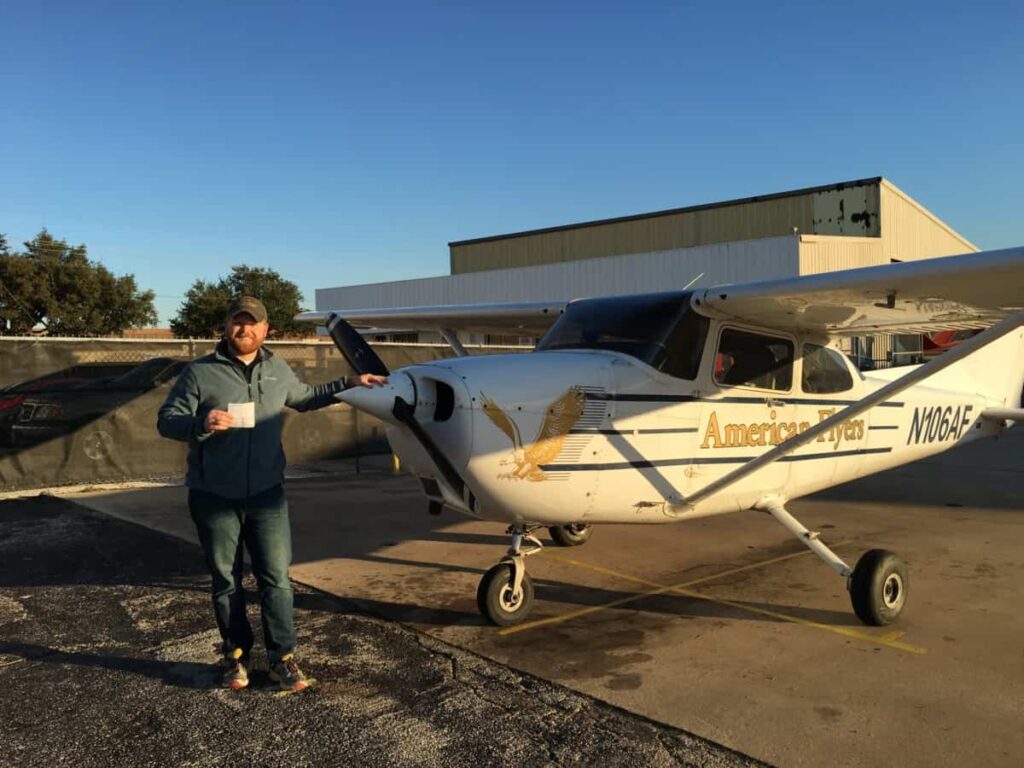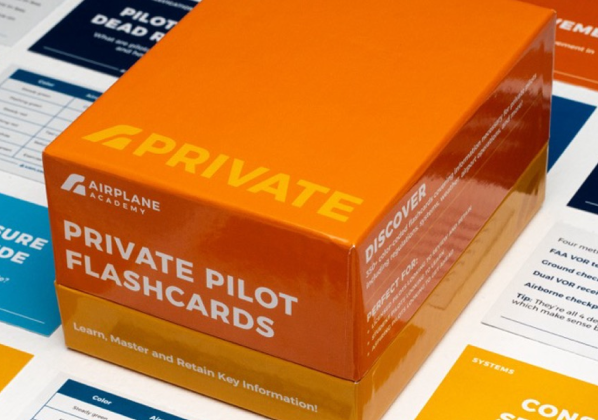
The airlines are a cool place to be. Or at least that’s what they keep telling me. As a Certified Flight Instructor (CFI) I’m chasing the same goal as others: the coveted 1,500 hours to get to the airlines. Time and time again I get asked, “how much do flight instructors make?”
Income for a Certified Flight Instructor (CFI) generally ranges from $30,000 to $60,000 per year ($15 to $30 per hour), but this depends greatly on experience, location, weather, hours flown, and demand. The greatest factor in compensation is how many hours you are able to fly.
Flight instructor compensation has a wide range and it really depends on a lot of factors such as how you are paid (hourly or salary), whether or not you are with a flight school (there are pros and cons to both), and how much you can fly. So let’s jump in.
Hourly vs. Salary
When viewing the average pay of a CFI, it’s pertinent to break it down into two parts: hourly and salary wages. Both have benefits and pitfalls, it just depends on what your goal is as an individual. Let’s dive further. First we’ll view those CFI’s that are paid hourly:
Hourly
An hourly CFI can range from $7.25 (yes that’s minimum wage) to upwards of $50 an hour. Keep in mind you are paid for flight hours. This doesn’t include the pre-flight discussion, preflight planning, walk around, refueling or parking the plane, post-flight brief and review once back on the ground.
This is master on, master off time. This may seem low, but there are some ways to beef up the pay.
First, instructors can opt-in to work extra hours, or even sixth-days, to ramp up their pay. However, there’s a cap: according to FAR 61.195, a CFI is limited to eight hours of flight instruction given in a 24-hour period, and as someone who’s been a CFI for over a year, eight hours of teaching in an airplane in one day is a LOT. Eight hours for six days straight is simply unreasonable, so the actual pay differs week to week.
Second, CFI’s can offer ground or simulator instruction for a certain rate (depending on the skill of the instructor, level of simulator, etc.) to help add to the pay. Weather stinks? You can always ground or sim. Unfortunately, those are flight hours lost.
Third, certain flight schools offer bonuses for CFI’s who sign yearly contracts, have their students pass checkrides the first time or even bonuses for recruiting fellow CFI’s. If there’s drive and hustle from a CFI, the money is there.
Pros and Cons of Hourly
Hourly isn’t a bad way to go, especially if you just want to instruct part-time as a part-61 instructor at a mom-and-pop pilot school at an untowered field. The good part is hourly is usually less hours worked per week with more of a flexible schedule. The bad part: when weather comes in CFI’s may not make as much (or any at all) and not having a steady paycheck can be tough, especially with flight school loans piling on.
I’ve heard of hourly CFI’s making as low as $250 a week ($1,000 a month) or as high as $1,000 a week ($4,000 a month) after taxes. It really does depend on so many variables. Having steady income is important, especially with a family. That’s where salary pay comes in.
Salary
Where there’s a yin, there’s a yang. Everything that doesn’t work for those hourly CFI’s lifestyle can be easily replaced by a salaried pay. In certain situations a guaranteed paycheck is much more desirable. It all depends on the person’s family, lifestyle, loan and overall living situation.
Pros and Cons of Salary
Salary varies for CFI’s just as much as the hourly rate, but overall salary CFI’s get paid more in a given year. This is a huge benefit. The downside is that salary CFI’s can expect to work more, usually upwards of 60+ hours a week. The pay is better for supporting your family, but you work so much you may rarely see them.
I’ve heard of salaried CFI’s making anywhere from $28,000 a year to nearly $60,000 a year. These numbers vary depending on your life skills and experience, but most newly-rated CFI’s can expect to make something in this range.
Certain ways to boost the salary wage is similar to hourly. CFI’s can sign contracts, receive bonuses or simply ask to work sixth-days. In the end, it depends on you as an individual: are you hustling for hours to get to the airlines or do you have a family to support and want to instruct on the side? The answer lies within.
Note: Additional instructor ratings can also help increase your pay. Ex: an instructor with an instrument (CFII) and multi-engine instructor (MEI) rating will get paid more than an instructor who only has their CFI rating.
Independent vs. Flight Schools
Pay can differ greatly depending on your employer. Overall, CFI’s can make more hourly as an independent CFI who offers instruction to students at a random set schedule. The hard part is independent CFI’s have to find students on their own, make the schedule and also locate aircraft to train in. Not to mention assign homework and study material.
CFI’s at flight schools may not make as much, especially if they’re paid hourly. The benefit of working at a flight school is there’s more students readily available, and thus more hours. There’s more structure at a flight school, which requires less sourcing of study material from the CFI. The resources are there, so planes don’t have to be found. Also, maintenance is sometimes located on site, so if something is wrong with the plane, an A&P mechanic can come out and fix it.
Additionally, flight schools may offer group grounds, which is beneficial for a student and easier on a CFI who may rather be flying (I know a few). Lastly, some flight schools offer advanced flight simulators, which are crucial for teaching flows, procedures and practicing instrument approaches in simulated weather.
How many hours a month can I get?
The 1,500-hour rule, which went into effect in the U.S. in 2013, requires first officers for commercial airlines to have at least 1,500 hours of flight time, instead of the 250 hours previously required to qualify for an Air Transport Pilot (ATP) certificate. The regulation stemmed from the Colgan Air 3407 crash in 2009 and a congressional mandate that followed.
This is the sole reason why CFI’s are so “hour-thirsty.” They need the hours to get onto the next step. Although this 1,500 hour rule has been a hurdle for the airlines, resulting in a mass pilot shortage, it’s been a business opportunity for flight schools. Flight schools have recently grown tremendously due to the need to train more pilots to fulfill the airlines shortage.
Note: The 1,500 hour requirement doesn’t apply for certain schools that are approved for reduced ATP minimum hours (1,000 or 1,250).
So besides pay, hours are of utmost importance for CFI’s. I’ve personally worked at two flight schools and have friends instructing all over the U.S. The biggest insight I can give: the amount of flight hours the schools guarantee should have a big * next to it. IT VARIES.
On average, you can hope to get somewhere between 80 and 90 hours a month if you’re lucky. I’ve hustled and have accrued 125 hours one month, but there’s lows too: I’ve been weathered out, earning as low as 33 hours another month. That type of hour swing can be stressful, but it comes with the job. It’s an ebb and flow. Nothing is certain. This is, after all, aviation we’re talking about.
But what’s a niche to getting more hours? Here’s a quick list:
- Work at a nearby mom-and-pop flight school, flying with non-airline general aviation pilots to fill in during off days.
- Rent a plane with a buddy and fly somewhere fun, learning real-life skills along the way, while practicing what you know.
- Take maintenance flights, if working at a flight school.
- Go all in and buy a plane, flying on the side.
In aviation if there’s a will, there’s a way. It depends on how much you want to fly. I had an old instructor at a flight school who used to say “the hours are there, you just have to want them.”
Other Ways to Get Paid/Hours
Some other options to getting paid include doing a flight review for someone who needs it. Per FAR 61.56, this consists of a minimum of one hour of ground and one hour of flight that includes various maneuvers pertinent to the rating. Basically it’s up to the flight instructor to decide on what to cover, but the pay is there and there’s a couple hours the CFI may obtain during the process of giving a flight review.
Another option in gaining hours and pay is to be a CFII. If this is the case, you can fly with instrument students who have gone past their six month currency period (per FAR 61.57) and act as a safety pilot while they fly approaches. This is a quick and easy way to get paid more, accrue hours and evaluate an instrument student on their “under the hood” skills.
Additionally, if an instrument student doesn’t maintain currency for over a year, they must do an instrument proficiency check or IPC. What this consists of is listed under FAR 61.57(d), but basically it’s similar to an instrument checkride, however an applicant can go up with a CFII and do what’s essentially a watered-down instrument checkride. It’s a good way for applicants to remain current and an efficient way for a CFI to stack up more hours and pay.
Another way to fulfill hours and pay is to transport planes. This isn’t that common, but occasionally CFI’s hear of someone who needs a plane transferred for various reasons (most likely a buyer needs it brought home). This is another good practice at real-life cross country flying, all while building time and getting paid. Just remember to practice flying the plane a few times near an airport to get familiar with the aircraft. Just because you’re legal to fly an aircraft doesn’t mean you should.
Those who don’t want to instruct, but have a commercial license may follow the list of job opportunities listed under 14 CFR Part 119 which include crop dusting, banner towing and aerial photography, to name a few.
Building 1,500 Hours Yourself
For those who don’t want to teach and don’t have any interest in flying banners, there’s another way of getting hours, but it is NOT cheap. Let’s assume the most affordable route:
You and a buddy go in on a 1972 Cessna 150L. You’re lucky to find one for $20,000, or $10,000 a person. Not adding in registration, insurance, parking fees and maintenance (ranging from $1,000 to $5,000 a year) let’s consider fuel burn.
Having flown over 250 hours in a Cessna 150, I can tell you it averages 5.5 to 6 gallons at hour (if you lean it properly). Assuming $5 a gallon, that’s $30 an hour. Let’s say you get your bare minimum ratings: private pilot, instrument pilot and commercial multi-engine land ratings. You worked hard and got these ratings at the minimum: 250 hours. That leaves you 1,250 hours until you fly jets. At $30 an hour, this will run you $37,500, or $18,750 if you fly each and every hour with a friend (Cessna 150 holds two people. It’s a tight fit in there. Be warned).
Keep in mind this is the best case scenario. It doesn’t include the thousands to maintain and run the plane or the chunk of change you’ve already spent on receiving the proper ratings in order to qualify for an ATP.
My Point of View
Please keep in mind this is my opinion and is not sponsored or endorsed in any way by the flight school I currently work for.
I started training in 2007 when I was 16 with an independent CFI at an untowered field in central Texas. Following a series of life and career changes, I finished up my private license in 2017 and went to Arizona to finish flight training at a huge flight school in one of the busiest delta airspaces in the country. I’ve since worked at two big flight schools in Phoenix. Trust me when I say: I’ve seen the good, the bad and the ugly.
In what I’ve experienced, I’ve learned that there are truly pros and cons to both areas of training. I’ll break it down:
Taking the Long Road
The independent side of training has lots of ups. You can train when you want, fly when you want and not rush through a very important and dangerous hobby (or career) in flying planes. There’s time to soak in the information and really know what you need to. The structure is up to the CFI and they can spend as much or as little time focusing on your short-comings as you’d like. It’s also usually much cheaper to go this route, but it can take a lot longer to receive those ratings.
The downside of this training is it’s less structured. You only know what your CFI knows, so don’t put too many eggs in that basket. It’s better if you want to fly as a hobby. If you want to be an airline pilot, the lack of structure and procedures may hurt you in the long run. Also, the untowered field you train at won’t get you proficient at radio communications, trust me I learned the hard way.
Hurry Up and Fly
Flying schools also have ups and downs. The good is that it’s quicker to receive those ratings. The structure gives students plenty of opportunities to learn. Being immersed in a school lets students hang out with other pilots more and those late-night conversations can be a crucial step in making a good pilot. Also, planes are usually available, schools train in busier airspaces which forces pilots to think at a quick pace (helpful for the airlines).
The downside is that it’s expensive. So. Dang. Expensive. Schools range from $50,000 to easily $100,000 to get all the proper ratings. Another downside is it may be too rushed for some, and they won’t have enough time to soak in the knowledge.
Most Importantly, Love What You Do
After 14 months of instructing and over a dozen ratings signed off, I must tell you this: please instruct because you want to, not because you have to. Being a CFI is much easier if you love what you do. I know too many CFI’s who hate their job and it’s not only very stressful for them, it’s rough on the student and can result in more unsafe skies. If you don’t want to teach aviation, don’t. There’s other routes you can take. Teach flying because you love it.
I knew from the first flight, although I was extremely nervous, that I’m going to instruct for the rest of my life. It’s the hardest and most rewarding job I’ve ever had. Those midnight hours hunched over a FAR/AIM and sunrise simulator missions aren’t easy, but that feeling you get when you see a young person you taught land a plane for the very first time on their own, is strictly unforgettable.
I wish you all blue skies and tailwinds. I look forward to flying with you in the airlines, no matter which route you take. As always: fly safe, be smart and have fun.


